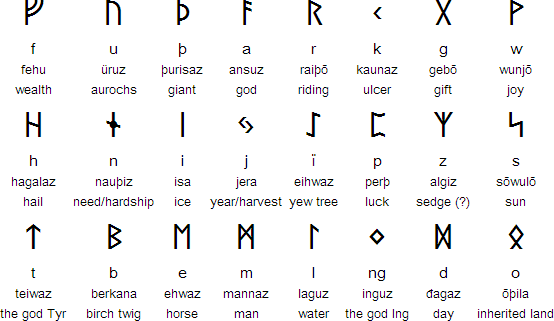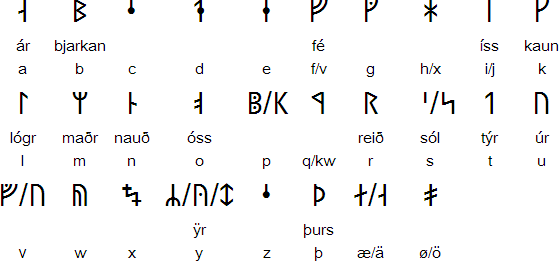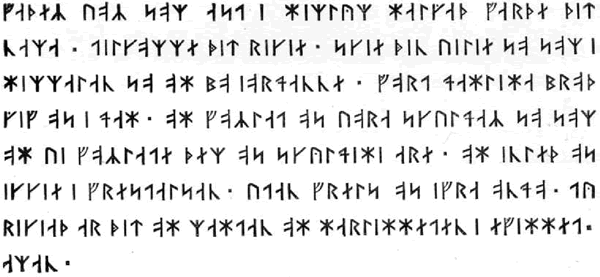Origin
Little is known about the origins of the Runic alphabet, which is traditionally known as futhark after the first six letters. In Old Norse the word rune means 'letter', 'text' or 'inscription'. The word also means 'mystery' or 'secret' in Old Germanic languages and runes had a important role in ritual and magic.Here are some theories about the origins of runes:
- The alphabet was probably created independently rather than evolving from another alphabet.
- Runic writing was probably first used in southern Europe and was carried north by Germanic tribes.
- The Runic alphabet is thought to have been modelled on the Latin and/or Etruscan alphabet.
Notable features
- The direction of writing in early Runic inscriptions is variable. Later they settled down into a left to right pattern
- Word divisions were not generally recognised in Runic writing, although one or more dots were occasionally used for this function.
Types of runic inscriptions include:
- 'Hrolf was here' type inscriptions on cliff walls, large rocks and buildings
- grave stone inscriptions, often with who carved the runes and who was buried, and also who made sure the stone was raised. (Later grave slabs or stone coffins were sometimes inscribed with Christian texts carved in runes)
- religious/magic inscriptions: prayers and curses, formulas on charms, etc.
- inscriptions related to trade and politics: There are many examples of trade communication: stock orders and descriptions, excuses for not having payed on time, trade name tags for bags or cases of produce, etc. The trade inscriptions are often carved on wooden rune sticks. Political inscriptions are to do with matters of the law, historical figures state that they were somewhere hiding from the enemy, secret messages to do with the fighting of wars, etc.
- personal letters: love letters, greetings between friends, proposals, etc.
- rude messages, similar to modern graffiti
- Art and craft-signatures: Goldsmiths, blacksmiths, wood carvers, church builders, etc., often put their name on what they made. Objects also somtimes had names carved onto them – either the name of the object itself, or the name of the person who owned it.
Elder Futhark
Elder Futhark is thought to be the oldest version of the Runic alphabet, and was used in the parts of Europe which were home to Germanic peoples, including Scandinavia. Other versions probably developed from it. The names of the letters are shown in Common Germanic, the reconstructed ancestor of all Germanic languages.
Notes
The letter k is also called kēnaz (torch) or kanō (skiff). The meaning of the letter name perþ is unknown.Younger Futhork
Younger Futhork or "Normal Runes" gradually evolved Elder Futhark over a period of many years and stabilized by about 800 A.D., the beginning of the Viking Age. It was the main alphabet in Norway, Sweden and Denmark throughout the Viking Age, but was largely though not completely replaced by the Latin alphabet by about 1200 as a result of the conversion of most of Scandinavia to Christianity.Three slightly different versions of the alphabet developed in Denmark, Sweden and Norway:
Danish Futhark

Swedish-Norwegian / Short-twig / Rök Runes

Norwegian Futhark

Gothenburg / Bohuslän Runes

Medieval (Latinised) Futhark
After the arrival of Christianity in Scandinavia, the Runic alphabet was Latinised and was used occasionally, mainly for decoration, until 1850.
Thanks to Niklas Dougherty for some of the information on this page.
Sample text - Lord's Prayer in Old Norse (Runic alphabet - Futhark)

Transliteration
Faðer uor som ast i himlüm, halgað warðe þit nama. Tilkomme þit rikie. Skie þin uilie so som i himmalan so oh bo iordanne. Wort dahliha broð gif os i dah. Oh forlat os uora skuldar so som oh ui forlate þem os skuüldihi are. Oh inleð os ikkie i frestalsan utan frels os ifra ondo. Tü rikiað ar þit oh mahtan oh harlihheten i ewihhet. Aman.Source: www.christusrex.org/www1/pater/JPN-norse-old.html
More information about Old Norse
Download these alphabet charts (Excel speadsheet)
Links
Information about the Runic alphabetshttp://en.wikipedia.org/wiki/Runic_alphabet
http://www.arild-hauge.com/eindex.htm
http://www.tha-engliscan-gesithas.org.uk/runes/
http://www.tarahill.com/runes/
Nytt om runer: Meldingsblad om runeforskning - the international periodical for runic studies
http://ariadne.uio.no/runenews/
An English Dictionary of Runic Inscriptions of the Younger Futhark
http://runic-dictionary.nottingham.ac.uk/
Runic Inscriptions
http://home.swipnet.se/~w-93783/
http://home.no.net/ekerilar/
http://www.nb.no/baser/runer/eindex.html
The mystery of the Runic alphabet - discusses the connections between Scandinavian and Turkic runes: http://www.antalyaonline.net/futhark
Runes Secrets - How to Use the Elder Futhark Runes
http://runesecrets.com
Free Runic fonts
http://www.rune-fonts.co.uk
http://www.fontspace.com/category/runic
http://www.thesauruslex.com/typo/hniaseng.htm
http://www.libdesigner.com/2012/04/19/25-runic-fonts-free-to-download/
http://www.sunnyway.com/runes/links4.html
Your name in runes
http://www.pbs.org/wgbh/nova/vikings/runes.html
ALPHABETUM - a Unicode font
specifically designed for ancient scripts, including classical
& medieval Latin, ancient Greek, Etruscan, Oscan, Umbrian,
Faliscan, Messapic, Picene, Iberian, Celtiberian, Gothic, Runic,
Old & Middle English, Hebrew, Sanskrit, Old Nordic, Ogham,
Kharosthi, Glagolitic, Old Cyrillic, Phoenician, Avestan, Ugaritic,
Linear B, Anatolian scripts, Coptic, Cypriot, Brahmi, Old Persian cuneiform:
http://guindo.pntic.mec.es/~jmag0042/alphabet.html









.jpg)
.jpg)


.jpg)





0 comments:
Post a Comment
Note: Only a member of this blog may post a comment.